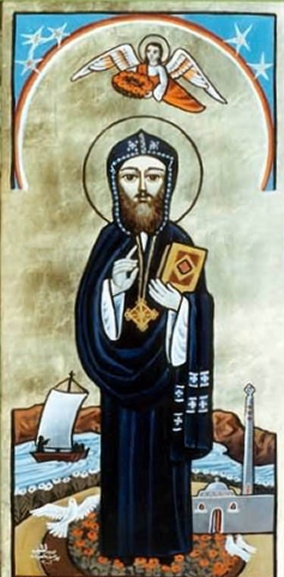Related Research Articles
Jacob Baradaeus, also known as Jacob bar Addai or Jacob bar Theophilus, was the Bishop of Edessa from 543/544 until his death in 578. He is venerated as a saint in the Oriental Orthodox Churches and his feast day is 31 July. Jacob's missionary efforts helped establish the non-Chalcedonian Syriac Orthodox Church, also known as the "Jacobite" Church after its eponymous leader, and ensured its survival despite persecution.
The Patriarch of Antioch is a traditional title held by the bishop of Antioch. As the traditional "overseer" of the first gentile Christian community, the position has been of prime importance in Pauline Christianity from its earliest period. This diocese is one of the few for which the names of its bishops from the apostolic beginnings have been preserved. Today five churches use the title of patriarch of Antioch: one Eastern Orthodox ; one Oriental Orthodox ; and three Eastern Catholic.

Severus the Great of Antioch, also known as Severus of Gaza or the Crown of Syrians, was the Patriarch of Antioch, and head of the Syriac Orthodox Church, from 512 until his death in 538. He is venerated as a saint in the Oriental Orthodox Church, and his feast day is 8 February.
John of Ephesus was a leader of the early Syriac Orthodox Church in the sixth century and one of the earliest and the most important historians to write in Syriac. John of Ephesus was a bishop, but John was more important than other bishops and what sets him apart from most others is the fact that he was a historian and a writer. He was also a political man and would often follow his own path. John was seen as a great writer and covered important aspects of events in history, and one of these important events was the plague, and John has one of the only first-hand accounts of the plague. He was also alive in what has been called the worst year in history, 536.
The Maphrian, originally known as the Grand Metropolitan of the East and also known as the Catholicos, is the second-highest rank in the ecclesiastical hierarchy of the Syriac Orthodox Church, right below that of patriarch. The office of a maphrian is an maphrianate. There have been three maphrianates in the history of the Syriac Orthodox Church and one, briefly, in the Syriac Catholic Church.
John III of the Sedre was the Patriarch of Antioch and head of the Syriac Orthodox Church from 631 until his death in 648. He is commemorated as a saint by the Syriac Orthodox Church, and his feast day is 14 December.
Athanasius II Baldoyo, also known as Athanasius of Balad, and Athanasius of Nisibis, was the Patriarch of Antioch and head of the Syriac Orthodox Church from 684 until his death in 687.
Saint Ephraim of Antioch, also known as Saint Ephraim of Amida, was the Patriarch of Antioch, and head of the Greek Orthodox Church of Antioch, from 527 until his death in 545. He is venerated as a saint in the Eastern Orthodox and Catholic Churches. His feast day is 8 June.
Paul II the Black, also known as Paul of Bēth Ukkāme, was the Patriarch of Antioch and head of the Syriac Orthodox Church from c. 551 or 564 to his deposition in 578. He succeeded Sergius of Tella as the spiritual leader of the Syrian non-Chalcedonians, in opposition to the Chalcedonian Imperial Church, and led the nascent Syriac Orthodox Church as it endured division and persecution.
Peter III of Callinicum was the Patriarch of Antioch and head of the Syriac Orthodox Church from 581 until his death in 591. He is commemorated as a saint by the Syriac Orthodox Church in the Martyrology of Rabban Sliba, and his feast day is 22 April.
Zuqnīn Monastery was a Syriac Orthodox monastery near Diyarbakır in Turkey. It produced one patriarch and fourteen bishops.
Elias I of Antioch was the Patriarch of Antioch and head of the Syriac Orthodox Church from 709 until his death in 723. He is commemorated as a saint by the Syriac Orthodox Church in the Martyrology of Rabban Sliba, and his feast day is 3 November.
Athanasius I Gammolo was the Patriarch of Antioch and head of the Syriac Orthodox Church from 594/595 or 603 until his death in 631. He is commemorated as a saint by the Syriac Orthodox Church in the Martyrology of Rabban Sliba, and his feast day is 3 January.
Iwannis I was the Patriarch of Antioch and head of the Syriac Orthodox Church from 739/740 until his death in 754/755.
Athanasius IV Salhoyo was the Patriarch of Antioch and head of the Syriac Orthodox Church from 986/987 until his death in 1002/1003.
Ignatius II was the Patriarch of Antioch and head of the Syriac Orthodox Church from 878 until his death in 883.
Severus II bar Masqeh was the Patriarch of Antioch and head of the Syriac Orthodox Church from 667/668 until his death in 684. He is commemorated as a saint by the Syriac Orthodox Church.
Julian II, also known as Julian the Roman or Julian the Soldier, was the Patriarch of Antioch and head of the Syriac Orthodox Church from 687 until his death in 708.
Athanasius III was the Patriarch of Antioch and head of the Syriac Orthodox Church from 724 until his death in 739/740.
References
- 1 2 3 4 Allen (2011), pp. 30–31.
- ↑ Mazzola (2018), p. 237.
- 1 2 Mazzola (2018), p. 239.
- 1 2 Young (1998), p. 601.
- 1 2 Lang (2001), pp. 32–33.
- ↑ Melton (2014), pp. 472–473.
- 1 2 3 Wilmshurst (2019), p. 806.